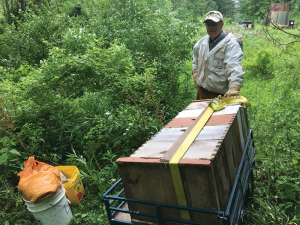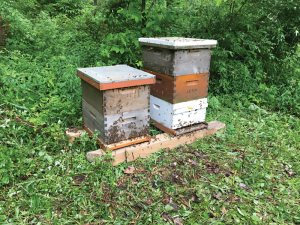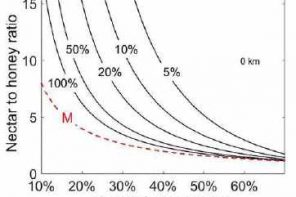Processing thick honey from heavy combs. An aggressive colony in a suburban area.
My opening comment last month
For this continued honey processing topic, I can’t write an article opening that is any better than the one I used to open my Bee Culture piece last month. Though I said that my obligation was over, the old thick honey saga really didn’t stop last month. Here is the reused opening:
Extracting from cold, older combs
I am so, so sorry I started this topic. Last month I boldly said that I would finish my comments on late season (or out of season) honeycomb extraction this month (April). That was just a bit optimistic on my part. However, I have made progress.
This is an update to my previous old honey update. You see I still had extracting to finish after the monthly article was complete. I feel that I have been clear in my appraisal of this interminable task – it is not enjoyable work. As I was heating, uncapping, and extracting the remaining old combs, yet another cockamamie idea struck me.
“Since much of the honey remains within the combs that I will be putting back on the colonies for them to clean, what if I uncapped the heated combs and then gave the uncapped and unextracted combs back to the bees.”
I anticipated the bees removing the uncapped honey, using some of it, then restoring and recapping the remainder. As it were, the bees would essentially recycle the thick dark honey. I have never heard of such a thing but was keen to try it.
I selected strong colonies and gave them about seven to eight crudely unextraced combs in a deep super. I put the deep on the very top of the hive and soundly closed all but the lower entrance to preclude robbing. I know what you are thinking – what an awful job to give my unsuspecting bees. I suppose it was. My doomsday plan was to give the bees a shot at it. That not working, possibly I could – yet again – bring it back and go back to the extracting grind.
It worked – but not what I expected
I eagerly had a look the very next day. Bees were on the combs, but if possible – they seemed surprised – agog – overwhelmed — they seemed something. No bee in the colony had ever been assigned such a task. (I have no photos of the uncapped frames. Dripping, sticky, messy and my camera in the middle of this situation – didn’t happen.)
I would like to reuse a photo I used last month. It makes a point of what the bees confronted.
Though nearly all of the honey has been removed, the rebuilt comb is still unfinished. The cells have not been repaired – only the honey has been salvaged. It appears to be turning up in other frames and, in some cases, on the same frame. There is not a strong flow ongoing and the bees have plenty of combs for storage. They would not be producing new wax for comb repair under these conditions.
However, I can now remove these cleared combs in anticipation for later this season or in future seasons. The equipment is profoundly lighter. Please know that this was a lot of work. It would be much better to extract at the end of the production season rather than go through this process. Sometime, things happen that can’t be helped.
I should note…
I should note that some of the comb cells are a bit distorted. This characteristic is somewhat noticeable in the photo on the previous page. The cells on the left appear to be slightly facing to the left while other cells appear to be facing straight ahead. This is not camera lens parallax. While visually looking at the comb, the blemish is slightly apparent – very slightly. I suspect that the heat caused the wax to distort under the weight of the hot honey. When a flow is on, I will watch to see how the bees handle this slight distortion.
Is this project ever going to end?
Before I wore myself out trying to process these combs, I did acquire about six gallons of unfiltered honey. It seems fine, but it has been through a lot for the past two years. I would not be eager to eat it and don’t want to sell it either (or worse – give it away). As the season passes, I plan to dilute it just a bit and feed it back to the bees. Do any of you have experience feeding honey back to a colony?
A beekeepingly-unnerving event
Last Spring and this Spring, I began to acquire swarms that did not appear to be mine. I acquired three last year and – so far – two this year. The swarms are moving into empty stacked equipment that I have sitting around in my apiary. This season I was there when both swarms moved in so I could confirm that they were not coming from any of my hives – unless they left on a previous day – pitched on a limb somewhere, and then moved back to my yard. While this could have happened, that scenario seems contorted. I saw no unusual signs of swarm cells in my colonies. I do admit that I really want these five swarms to be new bees and not simply my bees swarming.
The feisty one1

Odd for me, I made no photos of the aggressive colony during daylight. This is the split and the parent (suspect) hive is to the right. Nothing special to see in the photo. At night, they were calm. Did they deserve to die?
One of last year’s swarms seemed particularly feisty and possessive. Though it was happy in my equipment, it was never very happy with me. But all things considered, last year we tolerated each other.
However, this year something went over the edge. As has always been my nature, if I am at home and doing something other than bees, once or twice per day I casually wander back to my apiary.
About a month ago, on one of my wandering trips to the apiary, as I was pensively standing there – considering the world – a bee or two came for me. I mean they were coming to get me – not just send me from the area. Slapping and swatting – this was not enjoyable, and I felt that the attack was underserved. It began to be a regular event. I began to put on a veil as a matter of course just to have a quiet walk. As the season progressed, I commonly had eight to 10 bees bombarding me. No problem with a bee suit on, but this behavior was completely new to my apiary. Then it began to get complex.
As I normally do, I bought a few packages for photographing and writing topics and a couple of queens for making splits. When I went to the bee yard to check the progress of these new bees and queens, I had these aggressive bees all around me. But here’s the bee rub – I could not tell exactly from which hive or hives these nasty bees were originating.

A moving screen. I also put one on the bottom with screen side down. The confined colony had plenty of ventilation.
As I write this – even in the presence of new beekeepers – I need to say that this was getting to be an unpleasant situation. I named the hive(s) my sentinel hive. It protected my entire apiary. As I opened the stockade fence gate surrounding my apiary, they were immediately there. I made rounds to all the other hives and could not tell that there was any entrance confusion coming from any of the hives. This situation was evolving in a suburban bee situation that was not enjoyable.
I considered this…
By putting that uncapped honey on three colonies that I discussed above, had I upset the mood in the beeyard? I was specifically careful to only have one entrance and to put the uncapped frames on top of the colony far away from the entrance. There was no mess, but in some way did I trip a trigger? I toyed with this idea for a couple of days before deciding it was not the issue. Inside the colonies where the uncapped honey-cleanup work was being completed, all was serene and calm. There were no indications of robbing or other beehive conflicts.
Not knowing what else to do…

I used an inner cover on top to prevent the eight-mesh screen from crumpling under strap pressure. Note the bottom deep screen inverted to allow for bottom ventilation.
Without real proof, I decided to blame the testy colony. You might say, “Couldn’t you tell by standing near other colonies?” No. There were bees everywhere – flying about in a normal manner except for the ones that were attacking me. So there were normal and abnormal bees everywhere. I simply could not tell from whence the malcontent bees came.
Then everything blew up…
It was a particularly pretty day. Regardless of my Jerk bees from the uncertain sentinel colony, I did bee work. It was a good day for sound protective gear and gloves. Being springtime, grass grows so my neighbor began to cut his. As he started, I shut down all operations, smoked everything, and left the scene, but I did realize that I needed to confess to him that I had an issue with my bees that I had never had before.
I told him the next day. He responded that a lot was happening in the back corner of our yards. He said that yellowjackets came after him the previous day and stung him three times. He had to quit mowing, but did spend time looking for the ground entrance to the yellowjacket nest.
I confessed all. It was far too early in the Spring for yellowjackets. I felt terrible (should I uppercase and bold, terrible?) My idiot bees went onto his property and stung him three times. I should tell you that my tolerant, friendly neighbor has had a profoundly serious medical procedure that is presently under control. It is not, not, not ever okay – ever – for my bees to torment him as he goes about his private business.
Later during the same day, my neighbor’s wife told my wife that several bees had also buzzed her the day before. She was about 40 yards from my apiary. She was not stung – thanks and thanks again for that gift. I have never had bees act like this in my Ohio life and especially in my home yard. I am completely responsible for my bees and had to do something dramatic.
I decided to kill the suspected colony
I don’t even want to write about the possible legal and personal ramifications of where this situation with uncontrolled marauding bees could go. In total frustration, I made the decision to kill the suspected colony and do it quickly. Note this. I have never intentionally killed a bee colony that was not in some way an Africanized colony or a colony afflicted with American foulbrood. Even then, the task was enormously distasteful.
Then came a temporary reprieve…
Editor Kim and I talked. He knew of a desperation technique for efficiently killing a colony to the very last colony member. That became my plan. But as a few hours passed, I waivered. I was not 100% sure that this was the colony – maybe all of my colonies were involved in some way. What an unpleasant thought that was. Either way, I had to be sure before I just willy-nilly started killing selected bee colonies.
A different amazingly good friend…
A good friend and beekeeper himself said I could put them on a remote part of his wooded property about thirty miles away. I was still not solving the problem, but I was moving the hot bees away from all human life – except the occasional hunter.
The move…
There was nothing special about the move. Typical night work and all that go with it. I did use heavy-duty moving screens. They were simply deep supers with eight-mesh hardware cloth stapled to cover the topside.
I used slats that were screwed to the hive sides. I also used a heavy ratchet strap that would encircle the entire hive. I did not mean for these hives to break apart during the relocation.
My bee friend, Bob R. helped load the two hives (a split and the parent hive) onto my truck and away we did go. The ride was uneventful. The final leg of the trip was a four-wheel drive experience, but Bob and I wanted these accused colonies away from civilization. It was bit of a pain to move to the final location, but a heavy yard wagon was put to great use.
What now?
I put them back together. Of course they were testy. They had been confined and jostled for many miles, but they found the hive structures in short time. My truck is in the remote background. The bees only followed about one-third of the distance back. I am going down tomorrow to look for queens in one or both hives. They will be eliminated. No reprieve there.
Back in the home yard, it has rained a lot, and a couple hundred of the testy bees were left behind. But today, three days later, things do seem much quieter; and my neighbor cut his grass for the first time since the event. If there are more events next month, I will give you a quick follow-up.
Killing bees is ugly, but sometimes…
At a meeting last night, a beekeeper made a special trip to his vehicle to bring in a leather glove with hundreds of stingers still attached. He described a colony worse than mine. After just a few days, he eliminated it before it began to attack his farm animals and chickens. He described bees that would follow him one hundred yards.
How much of this goes on amongst you beekeepers? I sense that this procedure is one that is not spoken of very often. Do any of you have stories?
That’s it.
Thanks for reading and please don’t be unhappy with this discussion. This event is a rare one for me, and it was not a happy time. I may be on the way to turning things around. I’ll let you know.
1This was a populous colony. In an effort to control swarming, I split the original colony into 1/3 and 2/3s. I did this before the colony(s) became a nuisance.
Dr. James E. Tew, State Specialist, Beekeeping, The Alabama Cooperative Extension System, Auburn University; Emeritus Faculty, The Ohio State University. Tewbee2@gmail.com; http://www.onetew.com; One Tew Bee RSS Feed (www.onetew.com/feed/); http://www.facebook.com/tewbee2; @onetewbee Youtube: https://www.youtube.com/user/onetewbee/videos















